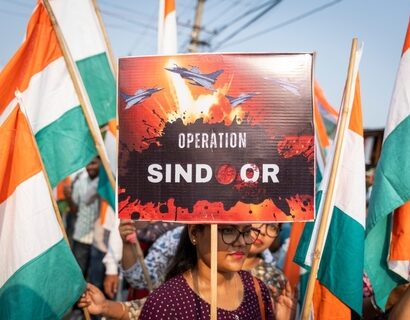Abstract: In the evolving landscape of warfare, certain analysts question the role of tanks, as drones and missiles dominate the battlefield. However, the analysis reveals that while tanks may diminish in importance, they remain crucial where terrain permits. Newer anti-tank guided missile (ATGM) systems offer increased mobility and protection, shifting the balance in their favour. Yet, the essence of combat tactics remains unchanged, with neglecting fundamentals leading to costly consequences.
Problem statement: How do modern anti-tank guided missiles influence the battle, and how does this affect the characteristics of the war in Ukraine?
So what?: In warfare, it is necessary to contextualise developments constantly. Today’s tacticians must consider a wide range of weapons that affect the engagement, not just ATGMs. To be effective, we must consider tactical problems comprehensively and sequentially.

The Development of ATGM
The development of ATGMs can be divided into up to five generations, each defined by advancements in the technology utilised. It is important to note that the different generations of anti-tank guided missiles cannot be strictly distinguished from one another. Rather, the differences overlap to some extent; thus, making a clear separation is very difficult. First-generation ATGMs introduced in the 1950s operated on principles of manual control, such as MCLOS (Manual Command to Line of Sight). Here, an operator had to manually guide the missile to the target via visual observation using wire guidance (one-way control).[1], [2]

Second-generation ATGMs were equipped with more sophisticated targeting and guidance systems that significantly improved their performance—second-generation missiles enjoy constant correction by both the operator and the system (two-way control) through guidance systems of the SACLOS type (Semi-Active Command Line Of Site).[3] These systems surpass first-generation ATGMs with accuracy rates exceeding 90% and have effective ranges from 2500m to 5500m. However, they are hampered in their flexibility because the operator still needs to guide the missile to the target.[4]
Around the end of the Cold War, some third-generation ATGMs addressed the drawback of operator vulnerability by introducing Fire-and-Forget capabilities (FaF). These utilise passive seeker heads to guide the missile to the target without intervention from the operator. Examples of third-generation ATGMs include the Spike family[5] and the FGM-148 Javelin developed by Raytheon Technologies and Lockheed Martin. The effectiveness of these systems was enhanced by the introduction of the “top attack” method.[6], [7]
In the case of the fourth generation, precise categorisation is even more challenging, as the author found no purely ground-based versions, only multi-platform systems for air-launched or vehicle-mounted use. Some of these systems utilise the ability to designate a target after firing[8] or have an even greater range (in air-launched versions)[9], which are significant improvements. However, most of these enhancements are likely not yet extensively tested and thus remain controversial for field deployment. The classification into a fifth generation, such as the Spike LR2,[10] is undoubtedly also a marketing measure, even though the network capability of the launch systems or the continuous abort capability represents novel developments.[11], [12]
The classification into a fifth generation, such as the Spike LR2, is undoubtedly also a marketing measure, even though the network capability of the launch systems or the continuous abort capability represents novel developments.

A noticeable aspect during the transition between generations is that the first two generations had to overcome the technical hurdle of accuracy and effectiveness in terms of hit probability and penetration capability. Once these were satisfactorily ensured, the operator’s protection was improved, beginning with the third and subsequent generations. The protection improvements didn´t exclude enhancements to the warhead, but priorities shifted. Initially, ATGM development focused on firepower, whereas now, protection holds at least an equivalent level of importance. Generally, it’s evident that as technology advanced,[14] ATGMs evolved as well – they became more mobile, more precise, and consistently increased in range.
From the historical development, the significant advantages and disadvantages of ATGMs can already be discerned. Operator vulnerability remains a problem with older in-service systems. With a flight time of 11.6 seconds over 2000m[15] for the PAL2000 (the Austrian designation for the Bofors RBS 56 BILL) and continuous control of the missile, there is great danger to the operator—especially if the launch signature cannot be concealed. Certain newer ATGMs compensate for this disadvantage, for example, with the possibility of remote operation, as seen in the picture of the Ukrainian Stugna-P below.

Tactical Evolution
“Russian tanks are having a bad time of it in Ukraine, suffering high casualties as Ukrainian troops, equipped with anti-tank guided missiles and armed drones, frequently ambush Russian armoured formations unaware of their surroundings and lacking dismounted ground support.”[17]
Now, the use of anti-tank guided missiles in Ukraine is considered based on tactical factors such as force, space, and time. Concerning time, two primary factors significantly contribute to the success or failure of military activities. Firstly, these are the availability of material and personnel in general and the time it takes to possess a capability to a sufficient extent. Competence and system proficiency are long-term objectives. Secondly, on a more tactical level, considerable time is required until infantry sufficiently takes contested terrain.
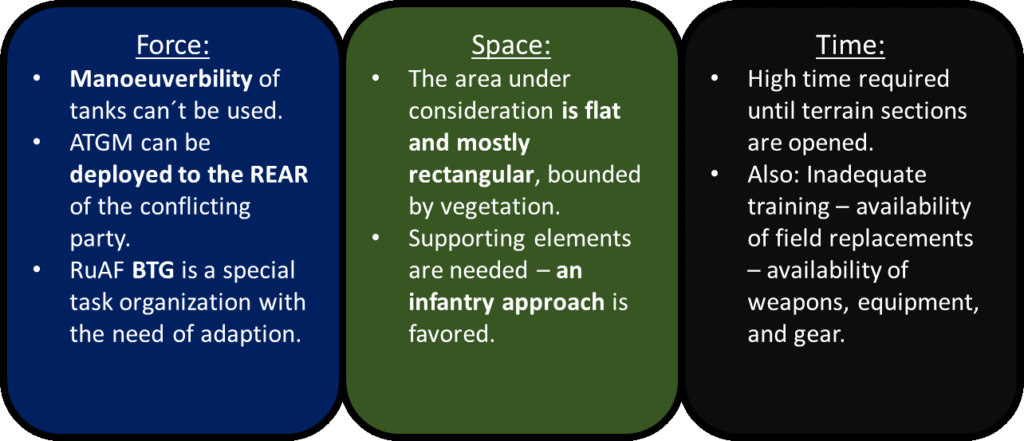
Force and Firepower
“Russia’s approach to combined arms warfare was generally to hammer Ukrainian positions with artillery and other stand-off weapons and then to send armoured vehicles forward on a manoeuvre termed “reconnaissance to contact,” designed to overwhelm what remained of Ukrainian defensive lines.“[18]
In 2022, the Russian Armed Forces (RUS AF) utilised battalion tactical groups (BTG) for small-scale combined arms warfare. These consisted of 600 to 800 soldiers (including a mixture of main battle tanks and infantry fighting vehicles), with a theoretically high proportion of combat and combat service support.[19] In theory, BTGs are highly effective and formidable formations. However, experiences in Ukraine have shown them to be impractical due to a lack of dismounted infantry.[20]
BTGs are highly effective and formidable formations. However, experiences in Ukraine have shown them to be impractical due to a lack of dismounted infantry.
The defending Ukrainian Armed Forces (UAF) countered the concentrated use of tanks by employing long-range anti-tank guided missiles. This prevented the Russians from utilising tanks for direct fire support to assist their limited infantry.[21] Nevertheless, observations of combat actions revealed that even multiple ATGM hits rarely resulted in tank destruction; instead, they often achieved a mobility kill (preventing the vehicle from moving).[22] However, the lack of outright ATGM-kills could also be attributed to modifications made to the tanks. Efforts were made to minimise thermal emissions (e.g., through camouflage materials), reduce the effectiveness of shaped charges through slat armour, or shift engagements to twilight hours whenever possible.[23], [24]
Force and Manoeuvre
The classic response to the threat posed by anti-tank guided missiles is to clear terrain using infantry. However, to evade the effects of long-range systems, a radius of at least 5km would need to be protected or monitored, but this needs to be matched with the range of ATGMs in use. In the case of Ukraine, third-generation ATGMs are being used en masse.[25] The extreme fluidity of combat operations in Ukraine and the time required for this play a role here. Apart from heavy combat zones defended by sufficient forces, combat is inevitably conducted with highly mobile forces that utilise various forms of transportation (electric motorcycles, beach buggies, pick-up trucks).[26]
Force Protection
However, the following must not be overlooked: “In the current conflict, we see relatively old combat tank systems facing each other, encountering the most modern ATGM systems.” [27] Although the ATGM systems already possess high firepower, the tanks used in the conflict at least protect the crew.[28], [29]
Evaluation of the “Force” Factor
When considering the factor of force in the context of combat operations in Ukraine, one problem arises. Concerning the organic peculiarity of the BTG, deep penetration attacks are fundamentally feasible when the rear area remains open. However, this assertion generally applies only at the onset of combat operations when mine density has not yet become overwhelming. Another force should ideally assume the task of keeping the rear area open. However, in the Russian case, this was often not accomplished.
Consequently, the BTGs could exploit opportunities for thrust at the beginning of operations. However, they could not sustain them due to being stretched thin by numerous tasks (deep penetration into the deep[30], keeping the rear open, and safeguarding the flanks). For the defending forces, modern anti-tank guided missiles specifically facilitate mobile deployment in the rear or on the flank.[31]
For the defending forces, modern anti-tank guided missiles specifically facilitate mobile deployment in the rear or on the flank.
As a result, the spearheads were swiftly separated from their logistical base, and the gained ground could not be held. It was recognised that the doctrine of “combined arms warfare” regarding force mixture and tasks assigned was not applied appropriately; rather, overextension, mine density, and presumably inadequate training led to partial failure.[32]
The Tactical Factor “Space”
Ukrainian terrain from Kyiv to the Black Sea is flat to gently hilly, with concealing vegetation (windbreak belts and partial woodland). These windbreak belts are a particular feature of the terrain and combat, which is oriented around them since they delimit the terrain.[33] This results in rectangular, open terrain sections that favour defences through concealed positions and open firing fields.
According to an analysis of Russian doctrine by Sebstian Czub, these open areas are overcome through combined arms warfare. Initially, the infantry is expected to seize important terrain features, followed by attempts to suppress defensive positions through artillery and direct fire support or by support infantry attacks.[34]

The map above was created by the “Institut für Militärisches Geowesen” of the Austrian National Defence Academy and further detailed by the author. It shows the village of Yehorivka at a scale of 1:50,000, highlighting the windbreak belts. This allows for better recognition of the resulting rectangles. Additionally, by observing the contour lines, one can see that the area is incredibly flat.
Evaluation of the Factor “Space”
The terrain around Yehorivka favours an infantry-centric approach. However, as noted above, this was rarely possible due to the lack of infantry support, with attacks predominantly executed by an armoured thrust, as evident from the analysed examples.[35], [36], [37]
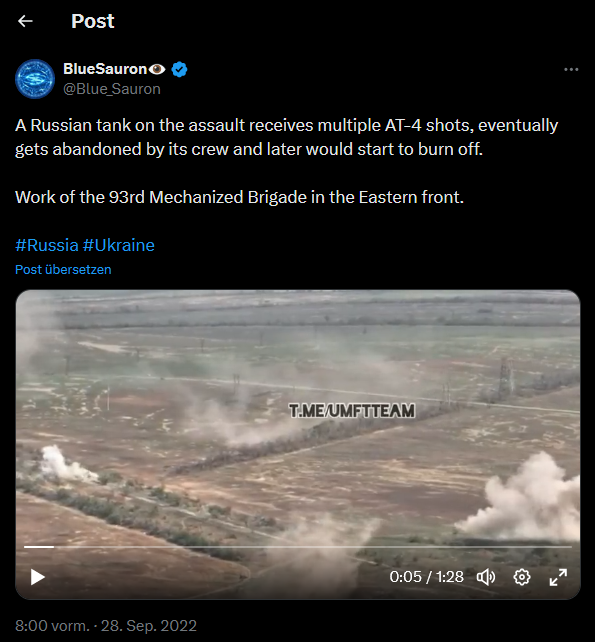
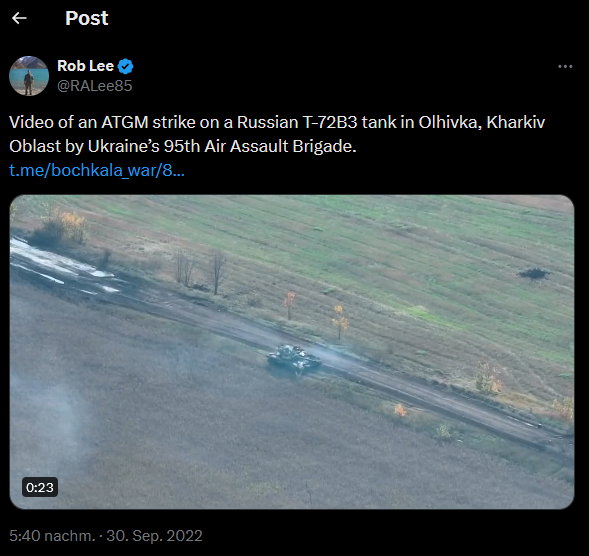
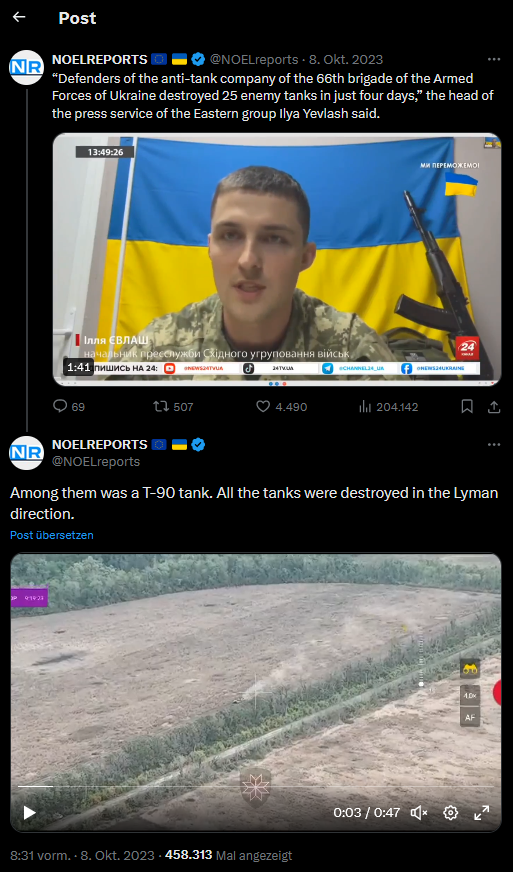
According to sources, the effective engagement range of ATGM in Ukraine is approximately 1400 meters. It seems, in this context, that modern ATGM can´t really make use of their advanced range. The peculiarities of the Ukrainian terrain allow for little more. The analysed combat examples also support this assessment.[38] Through reconstructed combat sequences, the author determined that in these cases, combat distances were even limited to around 1000 meters.[39]
Conclusions of the Factors “Force and Space”
In summary, it can be stated that the tactical principles regarding the employment of ATGM are generally valid. However, adjustments may be necessary in certain areas.
According to the author´s assessment, highly mobile units can rapidly deploy ATGMs deep within both friendly and enemy territory. Comprehensive “Rear” protection and new possibilities for ambushes and raids in the enemy’s “Deep” are also realizable, as the employment of mobile anti-tank teams at the very beginning of the invasion and also in the urban terrain showed.[40], [41], [42] The mobile offensive use of ATGM represents a significant change in combat tactics. However, it requires openings in the frontline and depth. Furthermore, the combat range of advanced ATGM systems is heavily restricted by terrain, emphasising the continued importance of terrain assessment. Overall, ATGM’s tactical principles are currently considered validated from the author´s perspective, especially in defensive scenarios where they can swiftly establish significant firepower. Even in larger areas, an armoured thrust can be repelled, at least temporarily, due to the mobility ATGMs provide.
Comprehensive “Rear” protection and new possibilities for ambushes and raids in the enemy’s “Deep” are also realizable, as the employment of mobile anti-tank teams at the very beginning of the invasion and also in the urban terrain showed.
The use of tanks must be assessed upon two dilemmas. Firstly, the balance between manoeuvrability and protection must be considered. Tanks are mobile elements for deep thrusts but currently require comprehensive protection, especially during offensive actions. The correct degree of systemic integration must be recognised and inferred. Secondly, the option of advancing tanks as leading elements of combat altogether must be considered. The trade-off between losses and security must be evaluated. Experiences in Ukraine have shown that crews are sometimes able to bail out. However, this cannot be expected with the use of comparatively lightly armoured vehicles like armoured personnel carriers or even HMMWVs.
After considering the principles and fundamentals, the author has determined that the basic tactics regarding modern ATGM have not significantly changed. If anything, the opposite is true, as established principles and fundamentals (e.g., the use of system integration, operational principles of ATGM, and tactical planning guidelines such as selecting appropriate terrain for certain systems) have proven valid.
Often, victory in combat is achieved through an adapted and, above all, correct application of tactics, not solely through the conspicuous use of an advantageous system. The lethality of available weapon systems, especially when employed in conjunction, allows no room for error.

The Battle for Yehorivka
Yehorivka is a village of 200 people in the Donetsk Oblast, Ukraine (47.70872432572923, 37.22345446084106). It was the combat scene from August 01, 2022, to November 15, 2022. In early August 2022, there was a noticeable slowdown in Russian offensive operations. However, sporadic offensive actions in the Bakhmut and Avdiivka areas persisted. On the Ukrainian side, a transition from a defensive to an offensive stance was apparent. Strategic attacks against the Russian “Rear” occurred, and the initiative shifted to the UAF.[44]

Operational Situation
The operational focus on the UAF side during the observed period was the counterattack in eastern Ukraine (Luhansk, Donetsk). Supporting operations were maintained in the Kharkiv area, and attacks were also launched in the Kherson Oblast. The RUS AF’s main effort was concentrated in Donetsk, with the objective of taking complete control of this area.[45] UAF shaping operations did not primarily occur in the Donetsk and Luhansk Oblasts, resulting in the RUS AF being shifted from Donetsk to Kherson. Consequently, the UAFs desired shaping effect was achieved in the Donetsk Oblast.[46]
Tactical Situation
On September 05, 2022, in the Donetsk/Luhansk Oblasts, the tactical situation was as follows: Intense fighting was observed in the areas of Bakhmut, Avdiivka, and Marinka. Approximately 40 km south of Marinka and the regional capital, Donetsk, are the villages of Vuhledar, Pavlivka, and Yehorivka. In this area, a strong axis of advance runs from east to west, facilitating encirclement into the flank of UAF in the northern Marinka and Avdiivka.[47]
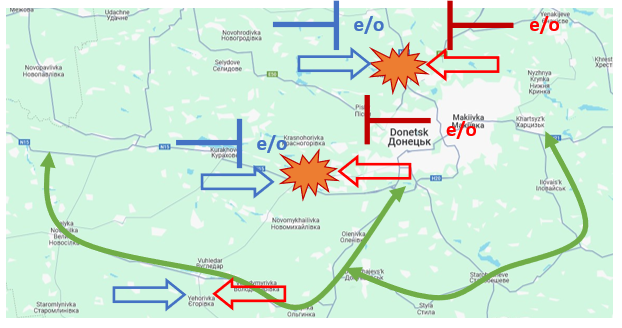
The green lines in the graphic show possible envelopments that the RUS AF could use to outflank the Ukrainian defenders.
The Course of Battle
The analysed combat action was reconstructed using geo-referenced data[48] based on the publicly accessible database with Russian losses by an OSINT aggregator.[49] A video depicting an armoured thrust by RUS AF, which UAF repelled with ATGM fire, was chosen as the basis for observations.[50] It must be noted here that in the video under consideration, not only were anti-tank guided missiles used, but the defensive success was achieved through the combined employment of various measures. However, the use of anti-tank guided missiles can be examined effectively, both in isolation and during the whole battle, which can be seen as part of a larger operation, which is why this example was chosen. Starting with this video, the frontline was verified, followed by selecting a suitable timeframe. Finally, an attempt was made to integrate the geo-referenced reports into a coherent sequence of events.
Chronological Sequence of Battle
From August 09 to August 16, 2022, the village of Yehorivka was attacked by the RUS AF and defended by the Ukrainian 53rd Mechanised Brigade. The village was initially held but was subsequently taken by Russian forces. Video footage confirms[51] that Russian soldiers were monitoring the village.
On August 30, 2022, the Ukrainian 72nd Separate Mechanised Brigade caused RUS AF to retreat with indirect fire. It is assumed that a shift in forces occurred, allowing the Ukrainian forces to take control of the village. An article also confirms the 72nd Separate Mechanised Brigade’s participation in combat operations near Pavlivka (4 km north of Yehorivka).[52] From September 03 to September 28, 2022, Russian forces, supported by artillery and an armoured thrust, likely regained control of the village. Presumably, reconnaissance and indirect fire targeting from the Ukrainian 72nd Separate Mechanised Brigade shaped the battlefield, followed by the subsequent takeover of the village again by Ukrainian forces.[53] On October 03, 2022, a Russian counterattack with an armoured thrust was repelled. On October 20, 2022, several UAF armoured vehicles were destroyed. Presumably, a larger Ukrainian attack took place during this period, which was unsuccessful.
From the beginning of November until November 15, the terrain and the village were under Russian control, and the frontline shifted northwards. The Russian 155th Guards Marine Infantry Brigade attacked this area on November 03, 2022, resulting in significant losses for both sides. The Ukrainian forces had to withdraw the 72nd Separate Mechanised Brigade.[54]
The Battle On October 03, 2022
On the Russian side, an armoured thrust involving at least five armoured vehicles is observed, likely with direct fire support from a location approximately 2 kilometres east of the village (also within the windbreak belt), which is at least being suppressed. On the Ukrainian side, a tank was deployed east of the ATGM. The first Russian tank fired at this UAF tank. The remaining Russian armoured vehicles then withdrew, with the southernmost destroyed by an ATGM providing flanking fire.
Subsequently, in the video, Russian infantry is observed infiltrating the fortified positions of the Ukrainian defenders. These are engaged with targeted drone strikes. A BMP[55] vehicle picks up the Russian soldiers and also moves south. However, an ATGM engages it, likely from the same position as before.
Evaluation
The ATGM was deployed to flank the main direction of attack (from north to south). At the same time, a tank and infantry in fortified positions provided frontal defence. The Russian attack was executed through an armoured thrust. Although the ATGM scored hits, the Russian armoured vehicles were able to continue their withdrawal. The combat distance here is at most 2000 meters, depending on the exact position of the ATGM. There is no apparent repositioning of the ATGM.
However, the Russian attack was repelled through the coordinated action of the battle tank, ATGM, and infantry. The Russian direct fire support could not effectively engage.
Conclusion of the Battle
The chosen combat example illustrates that ATGM appears to be classically defensive. The tactical principles (also valid in the Austrian Armed Forces) were adhered to. The Russian attackers failed to synchronise their means effectively to establish fire superiority and ensure a successful attack.
In this small-scale engagement, the conclusions from the previous chapter are confirmed: ATGM is employed defensively (according to the principles) within a system integration (no standalone duelling capability), the opponent seeks to attack with mounted armour (trade-off between losses and security), and they cannot establish fire superiority in the area (combined arms warfare is not applied effectively). Consequently, the attack is repelled, and the attacker must fight to withdraw.
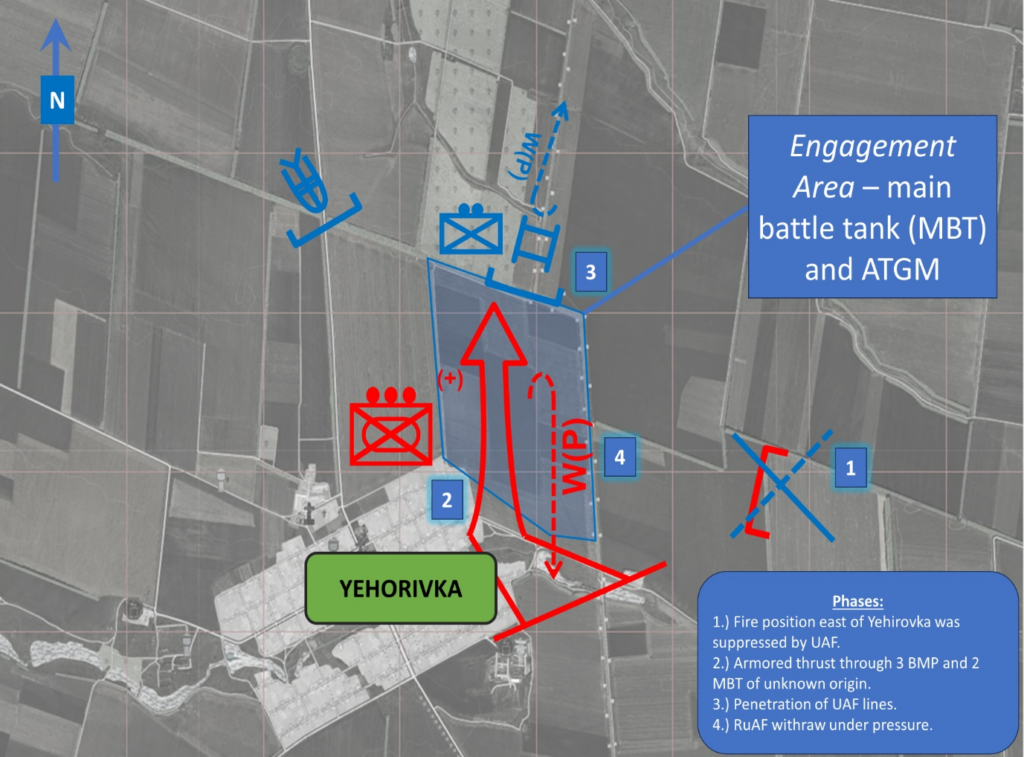
Diminishing Importance of the Tank?
In the ever-evolving character of warfare, analysts sometimes perceive a diminishing importance of the tank. However, the author disagrees with this notion. While drones, loitering ammunitions, as well as cyber and electromagnetic spectrum domains will continue to support combat operations, the author believes that the combination of various means remains crucial in achieving decisive outcomes. The desired effects are typically achieved through combined arms warfare, as per conventional doctrine, to impose the will on the enemy and achieve military victory within the intended military-strategic and strategic requirements.[56]
While drones, loitering ammunitions, as well as cyber and electromagnetic spectrum domains will continue to support combat operations, the combination of various means remains crucial in achieving decisive outcomes.
There is currently a lack of movement in combat, primarily due to the time-consuming and resource-intensive process of opening up terrain sections. The attacker must accompany sufficient infantry forces, which is essential. Additionally, the use of tanks (in conjunction with other elements) remains tactically advantageous where terrain permits, and it is not superseded by infantry-only combat or pure drone swarms. The protection and survivability of tank crews and advancements in active protection measures for tanks are the decisive factors in this regard.
For more modern ATGM systems, new deployment possibilities arise, even though the defensive nature of the weapon system has been confirmed. The system’s mobility and the operator’s protection are now provided to a sufficient and high degree, significantly increasing the advantages of using this system.
It can be observed that elementary tactics have not fundamentally changed due to the existence of modern ATGMs; this is because the modern ATGM is not a novel development but rather a continuously evolving one. Even though the principles of the employment of ATGM are validated and have evolved, the observed examples clearly demonstrate that neglecting principles and fundamentals in applied tactics leads promptly to losses, casualties, and potential defeat. This is precisely what happens when single MBTs are sent into the frontline with insufficient support and protection. Thus, the Ukraine example underscores the importance of the sound application of—supposedly outdated—the principles and fundamentals of combined arms warfare.
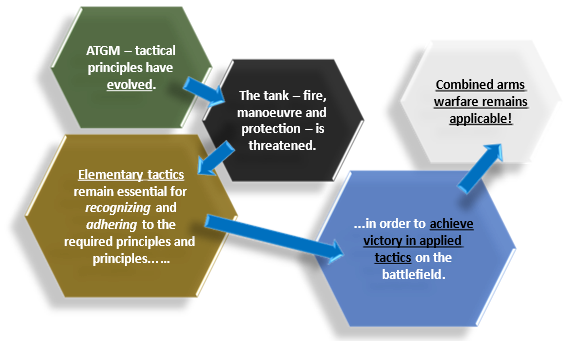
Captain Johannes Ginthör is an attendee at the 23rd General Staff Training of the Austrian Armed Forces. He has research interests in military affairs, armed forces deployment, planning, and development. Additionally, he is currently engaged in a Master’s programme in “Military Leadership” at the National Defence Academy in Vienna. The views expressed in this article are those of the author and do not necessarily reflect those of the Austrian Armed Forces.
[1] Jenzen-Jones Berman and Leff, “Anti-tank Guided Weapons,” 1.
[2] Dragan Pamučar and Slobodan Dimitrijević, “Multiple-criteria model for optimal Anti Tank Ground missile weapon system procurement,” 794.
[3] Ibid., 794-795.
[4] Jenzen-Jones Berman and Leff, “Anti-tank Guided Weapons,” 2.
[5] Author´s note: The Spike family is a series of guided missiles for various weapon systems.
[6] Jenzen-Jones Berman and Leff, “Anti-tank Guided Weapons,” 2-3.
[7] Lukas Kalla, interview by Johannes Ginthör, 2023.
[8] “India successfully test-fires SANT missile with ‘Lock-on After Launch’ & ‘Lock-on Before Launch’ capabilities, ” Times Now Digital: 2020, https://www.timesnownews.com/india/article/india-successfully-test-fires-sant-missile-with-lock-on-after-launch-lock-on-before-launch-capabilities/669661.
[9] “Upgraded SANT missile succesfully flight tested,” The Times of India: 2018, https://timesofindia.indiatimes.com/city/jaipur/upgraded-sant-missile-successfully-flight-tested/articleshow/66872743.cms.
[10] Rafael Land & Naval Systems Division, “SPIKE LR2”, Rafael Land & Naval Systems Division: 2023, https://www.rafael.co.il/worlds/land/spike-5th-gen-precision-guided-tactical-missiles/.
[11] Rafael Land & Naval Systems Division, 1-2, Rafael Land & Naval Systems Division: 2023, https://www.rafael.co.il/worlds/land/spike-5th-gen-precision-guided-tactical-missiles/.
[12] Lukas Kalla, interview by Johannes Ginthör, 2023.
[13] Wikipedia Commons, “Spike NLOS”, https://commons.wikimedia.org/wiki/File:2023-05-12_Spike_NLOS.jpg.
[14] Author’s note: Microelectronics, software engineering, optics, digital technology, materials science, etc.
[15] BMLV, “Die Panzerabwehrlenkwaffe 2000 und der Panzerabwehrlenkwaffentrupp,” 21.
[16] Wikipedia Commons, “Ukrainian Stugna-P ATGM”, https://commons.wikimedia.org/wiki/File:Ukrainian_Stugna-P_ATGM_Firing_in_Winter.jpg.
[17] Michael P. Losacco, “An Unerring Sense of Locality: Ukraine and the Future of Armored Warfare”, Modern Warfare Institute:2023, https://mwi.westpoint.edu/an-unerring-sense-of-locality-ukraine-and-the-future-of-armored-warfare/.
[18] Seth G. Jones, “Russia´s Ill-Fated Invasion of Ukraine,” 5, Center for Strategic & International Studies: 2022.
[19] Author’s note: From integrated reconnaissance to electronic warfare, pioneer support, transportation units, maintenance, and provisioning.
[20] Jones, “Russia´s Ill-Fated Invasion of Ukraine,” 5-6, Center for Strategic & International Studies: 2022.
[21] Mykhaylo Zabrodskyi et al., “Preliminary Lessons in Conventional Warfighting from Russia’s Invasion of Ukraine: February–July 2022,” 18, Royal United Services Institute: 2022.
[22] Jack Watling and Nick Reynolds, “Meatgrinder: Russian Tactics in the Second Year of Its Invasion of Ukraine,” 17, Royal United Services Institute: 2023.
[23] Ibid., 16-19.
[24] Manfred Stacher, interview by Johannes Ginthör, 2023.
[25] T.X. Hammes, “Game Changers: Implications of the Russo-Ukraine War for the Future of Ground Warfare,” 10-14, Scowcroft Center for Strategy and Security: 2023.
[26] Manfred Stacher, interview by Johannes Ginthör, 2023.
[27] Manfred Stacher, interview by Johannes Ginthör, 2023.
[28] Cranny-Evans, “Lessons from Ukraine: Armoured Fighting Vehicles,” 8, European Security & Defence: 2023.
[29] Author’s note: Here, particular reference is made to the Western variants, which are better equipped in terms of protection. Russian models, for example, are not comparable in terms of protection, such as ammunition storage.
[30] Department of the Army, “ADP 3-0 Operations,” 4-4 – 4-5, Department of the Army:2019.
[31] Lukas Kalla, interview by Johannes Ginthör, 2023.
[32] Manfred Stacher, interview by Johannes Ginthör, 2023.
[33] Manfred Stacher, interview by Johannes Ginthör, 2023.
[34] Sebstian Czub, “Russian Assault Tactics in Ukraine,” 6-11, Casimir Pulaski Foundation: 2023.
[35] Blue Sauron, “BlueSauron👁️ auf X: „A Russian tank on the assault receives multiple AT-4 shots, eventually gets abandoned by its crew and later would start to burn off. Work of the 93rd Mechanized Brigade in the Eastern front. #Russia #Ukraine https://t.co/I6N7omcmQq“ / X”.
[36] Lee, “Rob Lee auf X: „Video of an ATGM strike on a Russian T-72B3 tank in Olhivka, Kharkiv Oblast by Ukraine’s 95th Air Assault Brigade. https://t.co/avfKt824yz https://t.co/ScYVHYB3LA“ / X”.
[37] NOELREPORTS, “NOELREPORTS 🇪🇺 🇺🇦 auf X: „Among them was a T-90 tank. All the tanks were destroyed in the Lyman direction. https://t.co/WmxtWwqIAV“ / X”.
[38] Jack Watling and Nick Reynolds, “Meatgrinder: Russian Tactics in the Second Year of Its Invasion of Ukraine,” ii, Royal United Services Institute: 2023.
[39] Author’s note: The georeferenced data from the videos were used to identify the battlefield space. Subsequently, the videos were analyzed, with attention to impact angles, which were then traced back to the presumed firing positions, based on an assessment of the terrain through vegetation and elevation data.
[40] Benjamin Phocas and Jayson Geroux, “The School of Street Fighting: Tactical Urban Lessons from Ukraine – Modern War Institute”, Modern War Institute: 2022, https://mwi.westpoint.edu/the-school-of-street-fighting-tactical-urban-lessons-from-ukraine/
[41] Michael G. Anderson, “How Ukraine’s Roving Teams of Light Infantry Helped Win the Battle of Sumy: Lessons for the US Army – Modern War Institute”, Modern War Institute: 2022, https://mwi.westpoint.edu/how-ukraines-roving-teams-of-light-infantry-helped-win-the-battle-of-sumy-lessons-for-the-us-army/.
[42] Dan Parsons, “Ukrainian Battle Buggies Are Out To Kill Russian Tanks”, The War Zone:2022, https://www.twz.com/ukrainian-battle-buggies-are-out-to-kill-russian-tanks.
[43] Wikipedia Commons, “File: Captured RU T-62M 01.jpg – Wikimedia Commons”, Wikipedia Commons: 2022.
[44] Andrew S. Bowen, “Russia’s War in Ukraine: Military and Intelligence Aspects,” 13-14, Congressional Research Service: 2023.
[45] Institute for the Study of War, “Russian Offensive Campaign Assessment”, Institute for the Study of War: 2022, https://www.understandingwar.org/backgrounder/russian-offensive-campaign-assessment-september-5.
[46] Andrew S. Bowen, “Russia’s War in Ukraine: Military and Intelligence Aspects,” 13-17, Congressional Research Service: 2023.
[47 Institute for the Study of War, “Russian Offensive Campaign Assessment”, Institute for the Study of War: 2022, https://www.understandingwar.org/backgrounder/russian-offensive-campaign-assessment-september-5.
[48] Google My Maps, “@GeoConfirmed – War Ukraïne – Google My Maps,” https://www.google.com/maps/d/viewer?mid=10YK14-QB25penu8jeS4hBVarzGKZsVgj&hl=en_US&ll=47.74967636604571%2C37.29382912225216&z=12.
[49] Oryx, “Oryx”.
[50] Inside the Armed Forces of Ukraine, “Спецпризначенці НГУ знищили елітний підрозділ РФ на Донеччині. Бійці спершу обстріляли колону з п’яти танків, знищивши кілька з них разом з екіпажами. Потім переключилися на ліквідацію ворога, який засів в окопах. В результаті — знищено особовий склад та бліндажі.”
[51] Necro Mancer, “#Егоровка, Донецкая обл., дождь и какой-то очередной любитель южных стран из #810обрмп с трусами на морде жалуется, что укропы не сдаются (полное видео https://t.me/diza_donbass/1369) #всрф.”
[52] Luke Mogelson, “Trapped in the trenches.”, The New Yorker: 2022, https://www.newyorker.com/magazine/2023/01/02/trapped-in-the-trenches-in-ukraine.
[53] Blue Sauron, “BlueSauron👁️ auf X: „The Ukrainian 72nd Mechanized Brigade delivers a direct hit on a Russian BTR. #Russia #Ukraine https://t.co/rKXZbAnsct“ / X”.
[54] Luke Mogelson, “Trapped in the trenches.”, The New Yorker: 2022, https://www.newyorker.com/magazine/2023/01/02/trapped-in-the-trenches-in-ukraine.
[55] Author’s note: The abbreviation BMP stands for Боевая Машина Пехоты (Boevaya Mashina Pekhoty); roughly translated into English as: Infantry Fighting Vehicle.
[56] Curtis A. Buzzard et al., “The Tank is Dead … Long Live the Tank,” 7-8, Military Review Online Exclusive: 2023.

